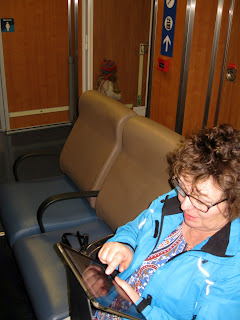Sarah McLaren and my 'Colour: A Personal Response' exhibition is on the road again.
The day before we loaded up the car...it was really full...
...and caught the first ferry the next morning.
We drove through Vancouver's persistent rain to Place des Arts Art Centre and Music School in Coquitlam. Conveniently there was dry underground parking with an elevator beside the entrance. It didn't take long to unload the car and get the work up to the main floor.
We laid sheets on the ground against all of the walls where our work would be hung. As we unpacked each work we placed it according to our layout plan.
There are 3 galleries in Place des Arts. We had been assigned the light-filled Atrium Gallery, much to our delight because it suits our body of work's concept so well.
Marziya and Jimmy are Place des Arts student volunteers who were ready to do anything needed. Once Sarah and I had decided on putting the 3D parts on plinths under glass, Marziya and Jimmy got to work putting them in position and removing the plexiglass covers.
The took on the challenge to assemble the colour cards on turntables which tested their colour wheel knowledge.
Then they replaced the covers.
The turntables full of colour cards and the framed collection are presented differently this time around because of the nature of the gallery space. The Atrium is a multifunctional largely unsupervised space used for musical events, dinners, a waiting room for parents and siblings while children attend classes, a meeting space... All of the small 3D items need to be protected which makes them no longer interactive but still interesting for people to look at.
Marziya cleans every single mark off the covers.
Challen and Joseph are a volunteer team that has worked together for 2 years hanging all Place des Arts exhibitions according to the Canadian National Art Gallery standards.
And they are good.
They hung every work perfectly and with well-rehearsed speed.
Don't you love the way their t-shirts match the artwork?
View from the upper level as we were about to leave.
Sarah and I left the staff, Bali, Josephine and Lidia, to spend the rest of the week making and mounting labels, adjusting lighting and setting up the gift shop. Sarah and I return to the galley on Friday for the official opening which is going to be fun - Friday, January 12, 7 - 9 pm.
We reloaded the car with the empty boxes...
...and caught the next ferry back to Victoria.
All of the Place des Arts staff were so helpful and supportive things went smoothly and we were home again by early evening very happy with the way the day had gone.
Do check out Sarah's blog to get her take on the day
here





























































